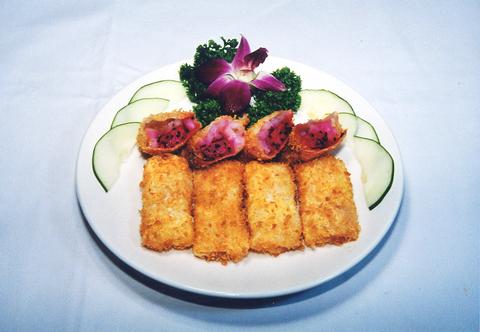Some may believe that the best food in Taiwan is in Taipei, but Ming Court in Hsinchu can disprove this generalization. Chef Tony Wong (王誠富), like many others worn out by working long hours in Hong Kong restaurants, have settled in Taiwan, bringing with them authentic Cantonese cuisine.
Ming Court is a medium-sized restaurant with 150 seats including private guest rooms, all furnished with Ming dynasty-style furniture. The elegant interior combines well with Wong's extravagant Cantonese cuisine, which he has been developing for over 20 years.
His secret weapon is his own XO sauce. Though reluctant to reveal his recipe, he says it includes ingredients like scallops, ham, and red pepper and is able to enhance the flavor of many foods. He even uses it with his current seasonal highlights, dishes featuring dragon fruit (火龍果), which is grown around Hsinchu and is in season until September.

PHOTO: CHANG JU-PING, TAIPEI TIMES
The meat of the dragon fruit has a similar texture to kiwi. It goes well with seafood and has been incorporated into dishes such as wok-fried fillet of garoupa and dragon fruit (NT$460) and crispy deep-fried seafood roll with dragon fruit (NT$300). Chen also cooks the flower of the vitamin C-rich fruit, which looks and tastes similar to lilies. It is served in sauteed dragon fruit flower and baby fish (NT$260) or try double-boiled dragon fruit flower soup with pork spare rib and bamboo (NT$220).
For those who aren't sure what to order, the restaurant also serves old favorites such as Cantonese fried noodles (廣式炒麵) or fried rice with chicken and salted fish (鹹魚雞粒炒飯), both at NT$250. The fried noodles are covered in an assortment of scallops, calamari, shrimp, barbecue pork and vegetables. Banquet menus are available for four, starting with an eight-course meal for NT$2,480, which includes the chef's special mixed seafood with coconut milk and curry sauce casserole. Banquets for 10 start with a 12-course set for NT$8,500 per table and range to NT$12,500 per table.

June 2 to June 8 Taiwan’s woodcutters believe that if they see even one speck of red in their cooked rice, no matter how small, an accident is going to happen. Peng Chin-tian (彭錦田) swears that this has proven to be true at every stop during his decades-long career in the logging industry. Along with mining, timber harvesting was once considered the most dangerous profession in Taiwan. Not only were mishaps common during all stages of processing, it was difficult to transport the injured to get medical treatment. Many died during the arduous journey. Peng recounts some of his accidents in

“Why does Taiwan identity decline?”a group of researchers lead by University of Nevada political scientist Austin Wang (王宏恩) asked in a recent paper. After all, it is not difficult to explain the rise in Taiwanese identity after the early 1990s. But no model predicted its decline during the 2016-2018 period, they say. After testing various alternative explanations, Wang et al argue that the fall-off in Taiwanese identity during that period is related to voter hedging based on the performance of the Democratic Progressive Party (DPP). Since the DPP is perceived as the guardian of Taiwan identity, when it performs well,

The Taiwan People’s Party (TPP) on May 18 held a rally in Taichung to mark the anniversary of President William Lai’s (賴清德) inauguration on May 20. The title of the rally could be loosely translated to “May 18 recall fraudulent goods” (518退貨ㄌㄨㄚˋ!). Unlike in English, where the terms are the same, “recall” (退貨) in this context refers to product recalls due to damaged, defective or fraudulent merchandise, not the political recalls (罷免) currently dominating the headlines. I attended the rally to determine if the impression was correct that the TPP under party Chairman Huang Kuo-Chang (黃國昌) had little of a

At Computex 2025, Nvidia CEO Jensen Huang (黃仁勳) urged the government to subsidize AI. “All schools in Taiwan must integrate AI into their curricula,” he declared. A few months earlier, he said, “If I were a student today, I’d immediately start using tools like ChatGPT, Gemini Pro and Grok to learn, write and accelerate my thinking.” Huang sees the AI-bullet train leaving the station. And as one of its drivers, he’s worried about youth not getting on board — bad for their careers, and bad for his workforce. As a semiconductor supply-chain powerhouse and AI hub wannabe, Taiwan is seeing